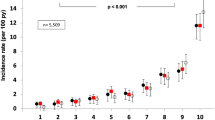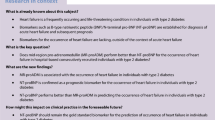Abstract
The prognostic value of NT-pro-BNP has not been thoroughly evaluated in diabetic inpatients with manifest cardiovascular disease. NT-pro-BNP was measured in 156 patients with type 2 diabetes mellitus hospitalised due to cardiovascular disease. The association of NT-pro-BNP with mortality and the combined endpoint (CE) of death, heart failure decompensation, stroke and myocardial infarction was analysed during a median follow-up time of 1183 days. Patients who died (1669 IQR 788–5640 vs. 398, IQR 158–990 pg/ml) and patients with CE (1353, IQR 730-4289 vs. 304, IQR 128–784 pg/ml, both p=0.0001) had significantly elevated NT-pro-BNP compared to patients without the corresponding endpoint. Patients with supramedian NT-pro-BNP (>518 pg/ml) had significantly worse outcome regarding mortality (HR 5.5, 95%CI 2.0–14.8) and CE (HR 5.0, 95%CI 2.2–11.2) than patients with inframedian values even after adjustment for age, NYHA class and renal function. At a cut-off of 422 pg/ml, NT-pro-BNP showed a sensitivity of 89.6% and a negative predictive value of 92.8% for detection of patients with future CE. In this sample of diabetic patients with a broad spectrum of cardiovascular disease, NT-pro-BNP was a strong predictor of long-term outcome. NT-pro-BNP measured at discharge identifies high-risk patients independently of the underlying heart disease.
Similar content being viewed by others
References
Garcia MJ, McNamara PM, Gordon T, Kannel WB (1974) Morbidity and mortality in diabetics in the Framingham population. Sixteen year follow-up study. Diabetes 23:105–111
Rendell M, Kimmel DB, Bamisedun O, O’Donnell ET, Fulmer J (1993) The health care status of the diabetic population as reflected by physician claims to a major insurer. Arch Intern Med 153:1360–1366
Solang L, Malmberg K, Ryden L (1999) Diabetes mellitus and congestive heart failure. Further knowledge needed. Eur Heart J 20:789–795
Miettinen H, Lehto S, Salomaa V, Mahonen M, Niemela M, Haffner SM, Pyorala K, Tuomilehto J (1998) Impact of diabetes on mortality after the first myocardial infarction. The FINMONICA Myocardial Infarction Register Study Group. Diabetes Care 21:69–75
Varela-Roman A, Shamagian LG, Caballero EB, Ramos PM, Veloso PR, Gonzalez-Juanatey JR (2005) Influence of diabetes on the survival of patients hospitalized with heart failure: a 12-year study. Eur J Heart Fail 7:859–864
Okin PM, Devereux RB, Gerdts E, Snapinn SM, Harris KE, Jern S, Kjeldsen SE, Julius S, Edelman JM, Lindholm LH, Dahlof B (2006) Impact of diabetes mellitus on regression of electrocardiographic left ventricular hypertrophy and the prediction of outcome during antihypertensive therapy: the Losartan Intervention For Endpoint (LIFE) Reduction in Hypertension Study. Circulation 113:1588–1596
Clark CM Jr, Snyder JW, Meek RL, Stutz LM, Parkin CG (2001) A systematic approach to risk stratification and intervention within a managed care environment improves diabetes outcomes and patient satisfaction. Diabetes Care 24:1079–1086
Krishnamurti U, Steffes MW (2001) Glycohemoglobin: a primary predictor of the development or reversal of complications of diabetes mellitus. Clin Chem 47:1157–1165
Lane JT (2004) Microalbuminuria as a marker of cardiovascular and renal risk in type 2 diabetes mellitus: a temporal perspective. Am J Physiol Renal Physiol 286:F442–F450
Maeda K, Tsutamoto T, Wada A, Hisanaga T, Kinoshita M (1998) Plasma brain natriuretic peptide as a biochemical marker of high left ventricular end-diastolic pressure in patients with symptomatic left ventricular dysfunction. Am Heart J 135:825–832
Pfister R, Scholz M, Wielckens K, Erdmann E, Schneider CA (2004) Use of NT-pro-BNP in routine testing and comparison to BNP. Eur J Heart Fail 6:289–293
Bettencourt P, Azevedo A, Pimenta J, Frioes F, Ferreira S, Ferreira A (2004) N-terminal-pro-brain natriuretic peptide predicts outcome after hospital discharge in heart failure patients. Circulation 110:2168–2174
Kragelund C, Gronning B, Kober L, Hildebrandt P, Steffensen R (2005) N-terminal pro-B-type natriuretic peptide and long-term mortality in stable coronary heart disease. N Engl J Med 352:666–675
James SK, Lindahl B, Siegbahn A, Stridsberg M, Venge P, Armstrong P, Barnathan ES, Califf R, Topol EJ, Simoons ML, Wallentin L (2003) N-terminal pro-brain natriuretic peptide and other risk markers for the separate prediction of mortality and subsequent myocardial infarction in patients with unstable coronary artery disease: a Global Utilization of Strategies To Open occluded arteries (GUSTO)-IV substudy. Circulation 108:275–281
American Diabetes Association (2004) Screening for type 2 diabetes. Diabetes Care 27[Suppl 1]:S11–S14
Cockcroft DW, Gault MH (1976) Prediction of creatinine clearance from serum creatinine. Nephron 16:31–41
Schneider CA, Helmig AK, Baer FM, Horst M, Erdmann E, Sechtem U (1998) Significance of exercise-induced ST-segment elevation and T-wave pseudonormalization for improvement of function in healed Q-wave myocardial infarction. Am J Cardiol 82:148–153
Fang ZY, Schull-Meade R, Leano R, Mottram PM, Prins JB, Marwick TH (2005) Screening for heart disease in diabetic subjects. Am Heart J 149:349–354
Das SR, Drazner MH, Dries DL, Vega GL, Stanek HG, Abdullah SM, Canham RM, Chung AK, Leonard D, Wians FH Jr, de Lemos JA (2005) Impact of body mass and body composition on circulating levels of natriuretic peptides: results from the Dallas Heart Study. Circulation 112:2163–2168
Valle R, Bagolin E, Canali C, Giovinazzo P, Barro S, Aspromonte N, Carbonieri E, Milani L (2006) The BNP assay does not identify mild left ventricular diastolic dysfunction in asymptomatic diabetic patients. Eur J Echocardiogr 7:40–44
Nielsen OW, McDonagh TA, Robb SD, Dargie HJ (2003) Retrospective analysis of the cost-effectiveness of using plasma brain natriuretic peptide in screening for left ventricular systolic dysfunction in the general population. J Am Coll Cardiol 41:113–120
Colhoun HM, Dong W, Barakat MT, Mather HM, Poulter NR (1999) The scope for cardiovascular disease risk factor intervention among people with diabetes mellitus in England: a population-based analysis from the Health Surveys for England 1991–94. Diabet Med 16:35–40
Luchner A, Hengstenberg C, Lowel H, Riegger GA, Schunkert H, Holmer S (2005) Effect of compensated renal dysfunction on approved heart failure markers. Direct comparison of brain natriuretic peptide (BNP) and N-terminal pro-BNP. Hypertension 46:118
Igarashi M, Jimbu Y, Hirata A, Tominaga M (2005) Characterization of plasma brain natriuretic peptide level in patients with type 2 diabetes. Endocr J 52:353–362
Luchner A, Hengstenberg C, Lowel H, Trawinski J, Baumann M, Riegger GA, Schunkert H, Holmer S (2002) N-terminal pro-brain natriuretic peptide after myocardial infarction: a marker of cardio-renal function. Hypertension 39:99–104
Bhalla MA, Chiang A, Epshteyn VA, Kazanegra R, Bhalla V, Clopton P, Krishnaswamy P, Morrison LK, Chiu A, Gardetto N, Mudaliar S, Edelman SV, Henry RR, Maisel AS (2004) Prognostic role of B-type natriuretic peptide levels in patients with type 2 diabetes mellitus. J Am Coll Cardiol 44:1047–1052
Gaede P, Hildebrandt P, Hess G, Parving HH, Pedersen O (2005) Plasma N-terminal pro-brain natriuretic peptide as a major risk marker for cardiovascular disease in patients with type 2 diabetes and microalbuminuria. Diabetologia 48:156–163
Verges B, Zeller M, Desgres J, Dentan G, Laurent Y, Janin-Manificat L, L’Huillier I, Rioufol G, Beer JC, Makki H, Rochette L, Gambert P, Cottin Y (2005) High plasma N-terminal pro-brain natriuretic peptide level found in diabetic patients after myocardial infarction is associated with an increased risk of in-hospital mortality and cardiogenic shock. Eur Heart J 26:1734–1741
Ray SG (2006) Natriuretic peptides in heart valve disease. Heart 92:1194–1197
Yamamoto K, Burnett JC Jr, Jougasaki M, Nishimura RA, Bailey KR, Saito Y, Nakao K, Redfield MM (1996) Superiority of brain natriuretic peptide as a hormonal marker of ventricular systolic and diastolic dysfunction and ventricular hypertrophy. Hypertension 28:988–994
Bibbins-Domingo K, Ansari M, Schiller NB, Massie B, Whooley MA (2003) B-type natriuretic peptide and ischemia in patients with stable coronary disease: data from the Heart and Soul study. Circulation 108:2987–2992
Januzzi JL Jr, Camargo CA, Anwaruddin S, Baggish AL, Chen AA, Krauser DG, Tung R, Cameron R, Nagurney JT, Chae CU, Lloyd-Jones DM, Brown DF, Foran-Melanson S, Sluss PM, Lee-Lewandrowski E, Lewandrowski KB (2005) The N-terminal Pro-BNP investigation of dyspnea in the emergency department (PRIDE) study. Am J Cardiol 95:948–954
Author information
Authors and Affiliations
Corresponding author
Rights and permissions
About this article
Cite this article
Pfister, R., Tan, D., Thekkanal, J. et al. NT-pro-BNP measured at discharge predicts outcome in multimorbid diabetic inpatients with a broad spectrum of cardiovascular disease. Acta Diabetol 44, 91–97 (2007). https://doi.org/10.1007/s00592-007-0248-4
Received:
Accepted:
Published:
Issue Date:
DOI: https://doi.org/10.1007/s00592-007-0248-4




